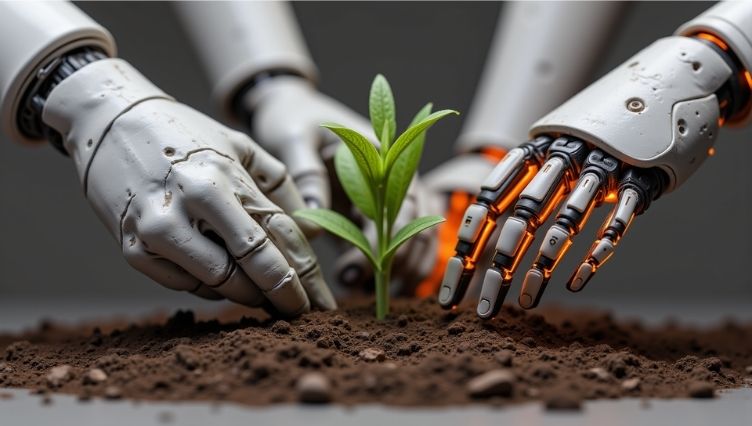The new era of automation is HERE.
And it’s powered by agentic artificial intelligence.
Traditional automation tools follow fixed rules: do this, then that, over and over again. Useful, but limited. Agentic automation takes things further. By applying agentic AI, systems can think ahead, adapt, and take action on their own.
This is where automation stops being a collection of isolated tools and becomes a real operating system for work. It doesn’t just execute instructions – it interprets, makes decisions, and executes complex, multi-step tasks with little need for human input.
That level of autonomy is why agentic process automation is moving fast up the priority list for businesses that want to scale, stay flexible, and stay ahead in changing markets.
How does Agentic Process Automation work?
From perception to continuous improvement and optimization
At its heart, Agentic Process Automation brings together advanced technologies to take on work that once needed human hands. AI agent can now reason, solve problems, make decisions, and carry out tasks with minimal human intervention.
That doesn’t mean people are out of the picture. We keep humans in the loop where it matters most – oversight, judgment, and control. The real leap forward is in the ability of these systems to manage complex tasks with something close to human intelligence.
That’s what makes AI agents and Agentic AI systems a defining force in modern automation.
So let’s open up the engine room of Agentic Process Automation:

Perception and data inputs: Agentic AI starts by gathering data from its environment – through APIs, databases, or direct user interactions. It can pull in both structured data from enterprise systems and unstructured information like emails. Using large language models (LLMs) and natural language processing (NLP), it interprets and connects these inputs into one picture. The result: the system always works with current, comprehensive information to guide data analysis and to take action.

Data processing and reasoning: once the data is collected, machine learning algorithms go to work. They extract meaning, spot patterns, predict outcomes, and guide how tasks should be planned and executed. Generative AI adds another layer here by producing predictive insights. This allows the system to test out possible scenarios, compare outcomes, and adjust its plans before taking action.

Goal-setting and decision-making: the AI agent sets objectives – either from predefined goals or user input. From there, it builds a strategy to achieve them, often using decision trees, reinforcement learning, or other planning methods. The AI agent combines fixed rules with adaptive algorithms to make data-driven decisions, weighing context, prioritizing tasks, and choosing the next steps based on both historical and real-time information.

Task execution and orchestration: after decisions are made, the system moves into action. AI agents connect with applications and APIs to carry out the plan, making sure each step in the workflow is executed in the right order and in sync with the others.

Continuous learning and optimisation: after the work’s done, the AI agent doesn’t just move on. It looks at what actually happened, takes in the feedback, and tries to do a bit better the next time. Sometimes it’s reinforcement learning, sometimes self-supervised tricks – either way, it’s basically trial and error at scale. The more it repeats tasks, the sharper it gets. And that’s the point: over time, it can take on harder jobs without falling apart. Business needs change fast, and systems like this need to keep up. Otherwise, what’s the point?

Real-time adaptation: at every stage, Agentic Process Automation adjusts in real time, keeping workflows responsive to sudden changes and unexpected events.
Key benefits of Agentic Automation for modern enterprises
Businesses are caught in the daily storm of shifting markets, urgent demands, and processes that never quite keep up. Teams work harder, but the gap is only getting bigger. This is where Agentic Automation steps in. It doesn’t just speed things up (at the beginning) – it clears the path from the obstacles.
Operations run faster, efficiency goes up, productivity expands, and suddenly there’s room for strategy instead of extinguishing the fire in panic.
In a world of dynamic environments that never slows down, that space is where real growth begins.
| Manage dynamic automations and workflows | ChatGPT and similar generative AI tools are fine for set formats. You ask, they answer, and that’s pretty much the limit. Agentic AI is a different beast. It can deal with surprises, switch gears when things change, and still stick to the guardrails it’s designed with. That’s important, because real business processes don’t sit still – they shift, stall, and throw curveballs. If your automation can’t adjust, it just gets in the way. Automation technologies don’t wait around; they can make decisions on the fly for complex or time-sensitive work without needing a person to step in. |
| Increase operational efficiency and productivity | Agentic AI pushes workload automation further by learning and getting better as it goes. That means teams don’t have to spend as much time managing the process and can put their energy into more important priorities. The result is smoother workflows, fewer mistakes, and resources freed up for the kind of strategic work that actually moves the business forward. For repetitive tasks, the need for people to step in drops to a minimum. |
| Improve flexibility and adaptability | An agentic automation platform gives organisations a more flexible way to handle shifting business needs. By watching real-time data and reacting as conditions change, AI agents can adjust to rising demand, sudden disruptions, or fresh information on the spot. That makes agentic automation both scalable and adaptable – a practical way to keep operations ready for the future. |
| Reduce errors and boost accuracy | Agentic AI pulls data from all kinds of systems, checks it against each other, and looks for anything that doesn’t line up. If it finds a mistake or something odd, it can either fix it itself or pass it along for a person to review. That way, a lot of the slip-ups that usually creep into repetitive or tricky tasks just don’t happen. |
| Strengthen data-driven decision-making | One of the biggest benefits is helping people make better decisions at every level. AI agents can go through huge amounts of messy, unstructured data much faster than any team could. They spot patterns and trends that humans would probably miss, which means the business can respond right away, adjust how things run, and even spot new opportunities for growth. In practice, it just makes decisions more data-driven. |
| Scale smoothly as the business grows | Agentic AI grows with the business. It can take on new applications, bigger data sources, and changes in infrastructure without slowing down. That means no constant worry about software updates breaking things or small tasks throwing automation off track. |
| Deliver a better user experience while giving employees more freedom to focus on meaningful work | Many enterprise search tools now use agentic AI to deliver unified support and operational integrity. With natural language processing, AI agents can understand what a user really means, analyze data, identify patterns, offer the right help, and even hold personalised conversations. That improves the customer experience and lifts employee productivity by taking repetitive tasks off their plate, leaving human workers with more time for creative and strategic work. |
How automated workflows can benefit multiple industries?
Change always feels like standing at the edge of deep water – uncertain, anxious, maybe even uncomfortable.
We might never be ready to jump. What if we fail?
But THIS is the place where you take the risk. And we can tell you it’s worth it.
Agentic Automation is built for exactly that: greater change, bigger shifts, new ways of working. The real risk isn’t jumping in – it’s standing still in the dangerous current, watching it slowly pull you away from the coast of success.
Agentic automation and AI technology are highly versatile and applicable across a wide array of business settings and industries. Unlike traditional automation, it helps streamline IT workflows, handle complex processes, automate customer support elements, and create more efficient recruitment processes.
This is where the power of Agentic Automation shows its true value – transforming business processes and operations into something faster and smarter.


Human Resources & Talent acquisition: resume filtering, answering the same candidate questions over and over, even onboarding tasks like contracts and benefits setup – Agentic automation can handle it like a pro. It can also prepare resources for new hires, update records, and gather feedback. HR gets to spend real time with people instead of forms.

Administration: benefits and compliance are full of data entry, manual claims, and regulations like HIPAA or GDPR. AI cuts the grunt work, reduces mistakes, and keeps the process inside the rules so people don’t have to chase errors.

Self-service support desk & IT operations: think of a help desk that fixes simple issues instantly. Password reset? Done. Access request? Sorted. When something harder comes up, it routes the ticket to the right team. It also keeps an eye on systems, runs diagnostics, and even applies fixes on its own.

IT security operations: to provide ongoing support for cybersecurity, automating critical tasks such as system and network vulnerability scanning, managing database backups, and executing incident response procedures to ensure long-term business security.

Finance & accounting operations: in financial operations, automation solutions handle complex tasks like invoice processing, fraud detection, financial reporting, compliance monitoring, and investment management. They analyze transaction data to detect unusual patterns, flag suspicious transactions, and assist in portfolio management.

Healthcare: to coordinate administrative workflows such as patient data intake, insurance eligibility checks, appointment scheduling, and billing processes. It can interpret unstructured clinical notes using NLP, extract medical insights, flag anomalies for staff, and help with compliance and care coordination.

Supply chain optimisation: to continuously monitor real-time data across inventory levels, shipping logistics, and vendor performance. They proactively identify disruptions, autonomously reroute shipments, and adjust procurement strategies to maintain the flow of production and enable supply chain efficiency.

Customer Experience (CX): to enhance customer experience through faster, more accurate, and personalised interactions. AI-driven chatbots handle inquiries, process orders, and troubleshoot issues, offering 24/7 support.

Manufacturing: Agentic automation drives efficiency through predictive maintenance, quality control, and supply chain management.

Public Sector: government agencies use agentic automation for document processing, data analysis, and resource allocation, enhancing citizen services and enabling data-driven decision-making.
Key infrastructure and technology requirements for Agentic Automation platforms
Artificial Intelligence (AI) and Machine Learning (ML) ensembles (AI models)
Agentic AI is a combo of different AI and ML techniques, including advanced approaches like reinforcement learning, deep learning, and supervised/unsupervised learning models for autonomous decision-making.
It also incorporates NLP and computer vision to understand documents and multi-modal data, and machine learning models to analyze historical data for proactive decisions. These AI models are the center of agentic automation.
AI Agents
AI agents serve as the foundational component of Agentic Process Automation. They are capable of executing complex tasks without continuous human supervision, interacting with business applications, managing APIs, and orchestrating workflows across systems and teams.
AI agents no longer wait for step-by-step instructions. They can observe their environment, reason about it, and decide on the best course of action. Instead of humans structuring every move, agents assess the data, spot patterns, ask new questions, and draw their own conclusions. They don’t just follow processes – they build them, execute the work, and choose the smartest path to deliver on the objectives you set.
They can act as collaborators, undertaking repetitive tasks to free employees for more creative and strategic work. AI agents can also collaborate within a multi-agent AI orchestration, where each agent specialises in a particular type of task. They can operate across silos, integrating with applications, APIs, and external systems to run workflows smoothly.
Agentic AI (Agentic Process Automation)
This represents the latest evolution, applying agentic AI to automation. It enables agentic AI to work smarter, take action autonomously, and dynamically adjust based on real-time data. Key differentiators for Agentic Automation include autonomy, goal-oriented behaviour, reasoning and problem-solving, adaptive learning, decision-making capability, and proactive behaviour.
Agentic AI combines the strengths of both RPA and IA, providing problem-free automation while intelligently orchestrating complicated workflows for improved results. Agentic Automation shines where things get messy – complex, multi-step tasks and unstructured data – but it doesn’t show up to push RPA or AI-powered automation off the stage. Instead, it puts them under the spotlight. By integrating with existing technologies, it creates a unified intelligent automation ecosystem – one that’s stronger, smarter, and built to handle the full spectrum of work.
Compared to traditional robotic process automation, agentic process automation significantly reduces the need for manual intervention while simultaneously increasing responsiveness to dynamic conditions. It effectively breaks process automation free from prescriptive rules and workflows, instead working towards a goal on its own.
Generative AI (GenAI)
A crucial technology within the framework of agentic automation, enabling advanced capabilities that extend beyond traditional rule-based systems.
While some GenAI tools, like ChatGPT, operate within fixed formats, their integration into agentic AI systems significantly enhances data processing by creating predictive insights, allowing the automation system to evaluate various scenarios and dynamically adjust its plans accordingly.
GenAI is fundamental in elevating agentic systems to understand, interpret, and generate human-like language, as well as to process complex, unstructured inputs such as emails and documents, bringing their functionality closer to human-like intelligence.
Process orchestration
A flexible and powerful process orchestration capability is essential to help AI agents coordinate tasks, manage complex workflows, and optimize business operations to achieve predefined goals. This includes supporting dynamic workflow execution and multi-agent collaboration across multiple systems, applications, and technologies.
Trigger identification (continuous process and event monitoring)
Agentic systems never blink. They watch processes, inputs, activities, and events – both inside and outside the business – with constant precision. And when a trigger appears, they don’t wait for instructions. They move, pushing AI agents into action at exactly the right moment.
Robotic Process Automation (RPA)
RPA is a critical capability for executing agentic automation, performing a majority of tasks throughout an end-to-end agentic workflow and gathering data across systems for AI models. This allows agentic automation to leverage existing automation tools and capabilities.
Learning systems and learning loops
Agentic systems must be able to autonomously learn from past experiences and adjust to improve performance, monitoring for errors and using feedback to optimise. This continuous learning is key to handling complex workflows that might be getting even more complicated.
Context grounding
AI agents need to understand their operating environment, including business rules, policies, historical decisions, and specific information about customers or products, requiring automated processes for AI agents to access this contextual data and predefined rules.
Assisted prompt engineering (Large Language Models LLMs)
This is crucial for enhancing the effectiveness of agentic AI that rely on large language models (LLMs) for natural language understanding and decision-making, enabling people to design and optimize prompts for greater precision and contextuality.
Human-in-the-loop principle
AI agents must be able to interact naturally with people through intuitive interfaces like chatbots. Agentic systems should simplify and automate workflows, remembering about significant human intervention, to allow people the quick identification and response to exceptions and performance issues. Human involvement is needed to ensure control and validation.
Security, compliance, and governance
AI systems often work with sensitive data, which means security can’t be given a second chance. They need AI-powered defenses that detect and neutralize risks on their own. At the same time, every automated process and AI-driven decision must be fair, unbiased, and compliant with regulations and predefined rules. That’s where autonomous auditing, constant monitoring, and human governance come in – securing not just the system, but the integrity of the entire operation.

What are the challenges in Agentic Automation implementation?
Agentic Automation opens the door to immense potential – but the path isn’t free from obstacles. Implementation comes with challenges that demand focus, discipline, and the right strategy to overcome.
At Office Samurai, we are great at collecting achievements for overcoming challenges.
Let’s talk about how we could make it work for you.

Ensuring reliable decision-making
The autonomy of Agentic Automation necessitates rigorous testing and validation in diverse scenarios to identify and address potential biases or errors. A comprehensive validation process, combined with human workers oversight, is vital to ensure reliable decisions..
Data privacy and security concerns
Agentic Automation runs on data – and often, that data is highly sensitive. Protecting privacy and ensuring security isn’t optional here – it’s the foundation. Implementing robust security measures, including encryption, access controls, and regular audits, is crucial to safeguard data and maintain compliance with regulatory requirements.
Navigating implementation complexity
The integration of AI and machine learning models can pose challenges during setup. Partnering with experienced partners can significantly streamline the process, helping navigate complexities for a smooth implementation. This includes integrating with multiple systems and existing enterprise systems.
Prioritising ethical AI practices
Deploying AI-driven automation always raises ethical considerations. Ensuring transparency in AI decision-making processes, addressing potential model biases, and maintaining accountability are critical for responsible AI implementation, building trust with stakeholders. This is key when allowing AI agents to automate processes.
How does agentic process automation differ from other automation types?
To select the most appropriate strategy for your needs, you need to understand the distinctions among Robotic Process Automation (RPA), Intelligent Automation (IA), and Agentic Automation.

Robotic Process Automation (RPA)
RPA is the workhorse of automation. It follows predefined rules to handle repetitive tasks like data entry or invoice processing – fast, precise, and reliable when the work is predictable. But its strength is also its limitation. RPA has no intelligence of its own. It runs in a straight line, struggles with change, and breaks when processes shift. That’s why it works best in simple, structured, rule-based tasks, not complex workflows.
Intelligent Automation (IA)
Building upon RPA, IA incorporates AI and ML, enabling more advanced decision-making. While these automation tools can operate independently, they frequently rely on predefined tasks and rule-based processes, with limited capacity for real-time action without human intervention or adaptation to change-prone scenarios. They may require manual reconfiguration for new scenarios.
Here is a comparison of their attributes:
| Agentic Process Automation | Stand-alone RPA | Intelligent Automation (non-agentic AI + automation) | |
| Adaptability | High It applies AI models and machine learning to learn from data, recognise patterns, and adjust actions in real time, reducing human involvement and ensuring workflow continuity and process optimisation. | Low It operates within fixed frameworks, executing tasks precisely as programmed without the ability to adapt to unforeseen changes or make contextual decisions. It often needs substantial human intervention when processes differ. | Medium It uses machine learning and Natural Language Processing to perform tasks but requires manual reconfiguration to handle new scenarios. |
| Task Complexity | High It uses AI models to divide projects into smaller tasks and orchestrates the execution of each part, leveraging LLMs and Natural Language Processing (NLP) to interpret and respond to complex inputs. | Low It is limited to straightforward, repeatable tasks. | Medium It excels at executing intricate workflows that involve well-defined and rule-based tasks but has a limited ability to make decisions or navigate changes in processes or operating environments. |
| Intelligence | High Agentic AI represents advanced artificial intelligence that powers high autonomy and adaptability of process automations. | Low Stand-alone RPA does not incorporate AI models, so intelligence is not an attribute of its automation capabilities. | Medium IA combines AI technologies with automation tools throughout the automation lifecycle, with the infusion of gen AI enabling some adaptation and responsiveness within defined process flows. |
| Scalability | High It employs IA frameworks that extend to diverse and complex workflows. | Medium Traditional RPA solutions enhance process scalability but can be challenging to scale across operating environments due to dependence on specific rules and manual configurations. | High It supports scalability with AI and machine learning to adapt and optimise processes. |
Human is NOT falling out of the loop
If you’re worried Agentic Automation is coming to take your job, you’ve got it wrong. These systems aren’t built to replace humans – they’re built to work with them.
Judgment, creativity, and accountability still belong to people. It’s like the machines take on the heavy lifting and the humans spot them.
Human-machine interaction, and the principle of human-in-the-loop, remain core pillars of Agentic Process Automation. They are not optional add-ons – they are the infrastructure that keeps trust, control, and accountability in place.

When agents are uncertain about how to handle a particular situation, they can utilize human-in-the-loop methodologies to get to the human validation. A robust validation process, combined with human in the loop oversight, is vital to guarantee reliable decisions in agentic automation. This is essential for achieving data-driven decisions. Low-code agent creation solutions should empower users to seamlessly connect to enterprise data, fine-tune prompts, and integrate human-in-the-loop systems without the need for advanced AI expertise.
For instance, in healthcare, agentic automation can assist hospitals and clinics in managing patient data and routine diagnostics, providing medical professionals with up-to-date information and the capacity to concentrate on delivering personalised care and handling exceptional cases. In scenarios where something unexpected occurs, deploying AI agents can automatically adjust processes, reroute tasks, or even request human assistance if needed.
The future of Agentic Process Automation
Agentic Process Automation isn’t standing still. It’s evolving fast – powered by breakthroughs in AI and fueled by the rising demand for intelligent automation across industries.
Analysts forecast rapid growth of agentic AI within enterprise software, reaching a third of all applications in the next three years, which will autonomously handle decision-making for 15% of everyday work decisions.
The increasing capabilities of AI agents using LLMs and gen AI are redefining how complex business processes can be automated. This represents a significant leap towards fully automated processes and augmenting human intelligence to automate tasks and costly processes.

Agentic Process Automation marks the real path to operational mastery. It isn’t just the next small step – it’s a strategic leap in how work gets done. At its core stand AI agents: powerful entities fueled by the intelligence of LLMs and the creative force of Generative AI, built to push beyond routine automation into a new era of capability.
Crucially, Agentic Automation does not replace, but complements and enhances existing tools such as RPA and IA, integrating them into an ecosystem where each technology performs its optimal function. This synergy allows businesses to tackle previously unautomatable processes, transforming business operations with human-like intelligence and minimal human intervention.
Mobilise your forces & embrace the Agentic Process Automation
For years, organizations have watched automation evolve in fragments: a bot here, a workflow there. But the game has changed. Agentic systems bring it all together – adaptive, autonomous, and capable of handling complexity at a scale humans alone cannot sustain.
This isn’t about adding another tool to your stack.
It’s about redefining the core of your workflows. It’s about turning operations into an intelligent ecosystem – one that learns, adapts, and delivers. The reward is clear: efficiency without compromise, productivity without burnout, and a future where your organization leads with autonomous strength instead of lagging in manual constraints.
The path is clear and the next move is yours. Ready?




